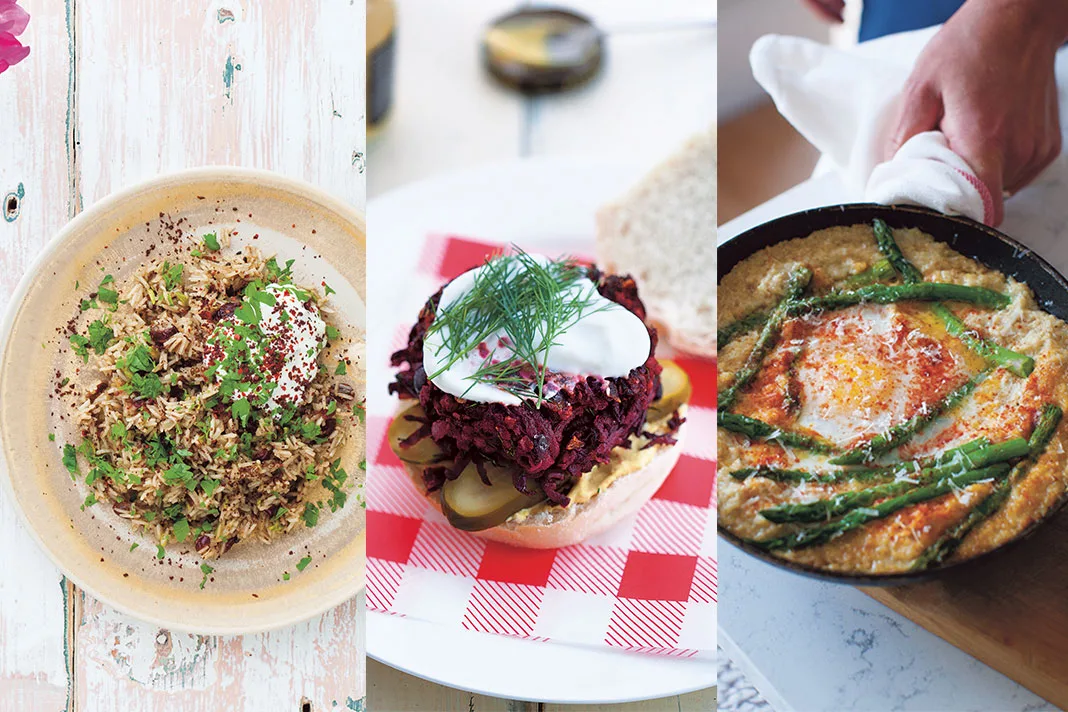In her new book The Art of the Larder, Claire Thomson shares some storecupboard recipes for dishes you can easily prepare at home
Recipes and Words by Claire Thomson
Everyday meals no longer have to be a bore. Chef, author and food writer Claire Thomson’s storecupboard recipes can easily be easily prepared at home.
4 Storecupboard Recipes
Baked Oatmeal with Eggs, Asparagus and Pimentón

Chewy and creamy, oats make a terrific substitute for potatoes or bread in storecupboard recipes. Use spinach instead of asparagus if you like. Also, bacon fried in the hot butter before adding the layer of porridge is sensational.
INGREDIENTS
100g rolled, jumbo or steel cut/ pinhead porridge oats (your usual porridge preference)
salt
1 bunch of asparagus, woody ends removed
40g butter
4 eggs
80g Parmesan cheese, grated
1 teaspoon pimentón – hot or sweet, as you like
METHOD
STEP 1: Make the porridge as per the packet instructions, adding 1⁄2 teaspoon of salt as it cooks. If you’re using steel cut/pinhead oats you’ll need more time to make this recipe.
STEP 2: In a pan of boiling water, cook the asparagus for 2–3 minutes, until just cooked.
STEP 3: Preheat the oven to 200°C/fan 180°C.
STEP 4: Put the butter into a non-stick ovenproof frying pan/ skillet and melt over a moderate heat.
STEP 5: With the pan hot and the butter foaming, add the cooked porridge to the frying pan/skillet, spreading it out roughly.
STEP 6: Arrange the cooked asparagus spears over the surface of the porridge, pushing them in slightly.
STEP 7: Make 4 pockets in the surface of the porridge and asparagus and crack an egg into each.
STEP 8: Sprinkle with the cheese and pimentón.
STEP 9: Put the frying pan into the oven and cook until the whites are set and yolks still runny. This will only take a few minutes so keep an eye on them.
Step 10: Remove from the oven and serve straight from the pan. I like to eat this with chilli sauce or some gojuchang (Korean red chilli paste).
Sour Cherry and Pistachio Pilaf

Heaven is a pilaf that makes everyone want to eat everything. This is my current favourite version: seductive, noble, and very, very beautiful. Ideally, toast the whole spices before you grind them.
INGREDIENTS
300g Basmati rice
3 tablespoons butter
1 onion, thinly sliced
3 teaspoons in total of ground spices – choose from coriander, cumin, pepper, turmeric, ginger, allspice, nutmeg, cardamom (use less of a measure if choosing from the last 3 listed)
1 cinnamon stick
75g dried sour cherries (or dried cranberries)
salt
100g shelled pistachios (or flaked almond)
225ml chicken stock, boiling, plus 225ml water, boiling (450ml in all, or use all water if you like)
To Serve:
200g plain yoghurt
1 small clove of garlic, crushed
2 teaspoons sumac (optional)
a medium bunch of herbs, leaves roughly chopped – parsley, dill or mint, or a combination
1 teaspoon chilli flakes, or to taste lemon wedges
METHOD
STEP 1: Wash the Basmati rice thoroughly and drain well.
STEP 2: Heat the butter in a pan over a medium heat, then add the onion and sauté for 8–10 minutes, until it turns completely soft. Add the spices, cherries and a generous pinch of salt and cook for 1 minute more.
STEP 3: Add the rice and pistachios and give a good stir over the heat for a minute or 2 to toast the rice, then add the liquid and check the seasoning.
STEP 4: Put a lid on the pan and cook the rice on high for 3 minutes, then turn the heat down to low and continue to cook for 15 more minutes, until all the liquid has evaporated and the rice is tender.
STEP 5: Take off the heat. Place a clean tea towel between pan and lid and let the pan sit and rest for 5 minutes. The tea towel will help draw excess moisture from the pan and helps to keep the rice extra fluffy.
STEP 6: While the rice is cooking, season the yoghurt with a bit of salt, the garlic and the sumac, if using.
STEP 7: When the rice is ready to serve, with a fork stir through the majority of the herbs, stuffing the rice as you go.
STEP 8: Serve the pilaf at the table, with the yoghurt, chilli flakes, remaining herbs and lemons to add per bowlful.
Black Bean and Beetroot Burgers

Serve these beet burgers with your choice of sour cream, mayonnaise, aïoli, pickles (sliced gherkins are fabulous here), lettuce leaves, goat’s cheese or feta. On rye bread or in a roll, find a combination that works for you.
INGREDIENTS
1 onion, finely diced
1 tablespoon olive oil
2 cloves of garlic, finely sliced
2 medium beetroot (about 300g), peeled and grated
1 x 400g tin of black beans, rinsed and drained, then roughly mashed with a fork
1 tablespoon Dijon mustard
1⁄2 teaspoon sweet paprika – smoked or unsmoked
1 teaspoon cumin seeds, toasted and ground
1 teaspoon coriander seeds, toasted and ground
a small bunch of fresh dill, leaves roughly chopped
80g rolled oats – or use breadcrumbs, if you like
salt and freshly ground black pepper (about 1 teaspoon salt and 1⁄2 teaspoon pepper)
neutral cooking oil (sun flower or vegetable), for frying the burgers
METHOD
STEP 1: Cook the onion in a small saucepan with the olive oil until soft and translucent, about 8–10 minutes, then add the garlic and cook for 2 minutes more, until fragrant.
STEP 2: Remove from the heat and set to one side.
STEP 3: Combine the grated beetroot, beans, mustard, spices, dill, oats/breadcrumbs and seasoning in a bowl. Use your hands to work the mix together until cohesive and easily shaped.
STEP 4: Shape the mix into burgers about 2cm thick and place them on a tray or plate. Put them into the fridge to firm up for an hour or so.
STEP 5: Heat a large non-stick frying pan with enough oil to cover the surface of the pan and about 1cm deep, and fry the burgers over a moderate heat for 2–3 minutes on each side, until crisp and the interior is hot.
STEP 6: Remove from the heat and serve immediately.
Halloumi Saganaki

When it comes to storecupboard recipes, halloumi has a tremendous shelf life and my fridge is rarely without it. Saganaki is a Greek preparation using this well-loved squeaky cheese. Dip the slices into beaten egg and roll them in semolina and sesame seeds before frying, then drench with honey and dried oregano. Squeeze over lemon and serve with chopped fresh ripe figs, peaches, apricots or some grapes, with good bread to mop up the juices.
INGREDIENTS
1 handful of semolina, or use plain flour
1 tablespoon sesame seeds
250g block of halloumi cheese
1 egg, beaten
3 tablespoons olive oil
2 tablespoons runny honey
lemon, to squeeze, plus lemon wedges, to serve
1⁄2 teaspoon dried oregano
a pinch of chilli flakes (optional)
1 spring onion, finely sliced (optional)
METHOD
STEP 1: Mix the semolina or our and sesame seeds together.
STEP 2: Cut the halloumi into thick slices. Dip the slices in the beaten egg, then roll in the our mix.
STEP 3: Heat the olive oil in a non-stick frying pan and fry the cheese on a medium heat for about 2 minutes on each side, until golden brown.
STEP 4: Drizzle with the honey and a squeeze of lemon and sprinkle with oregano and chilli flakes and spring onion, if using. Serve with lemon wedges.
For more storecupboard recipes see:
The Art of the Larder by Claire Thomson (Quadrille, £20)
Photography: Mike Lusmore







